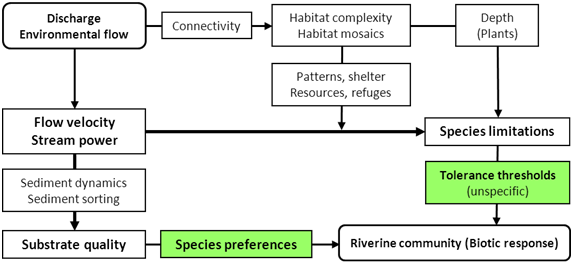To provide practical guidance for river assessment and rehabilitation, the complex interactions between various hydromorphological (HYMO) processes and variables and the response of stream biota were pragmatically reduced to key structures, mechanisms, and cause-effect chains. For example, high flow velocities physically limit habitat use by weak swimmers, and high stream power maintains habitats with coarse gravel (Figure 1). Thus, high flow velocities and coarse gravel emerged as key indicators for HYMO integrity that are relevant to aquatic organisms. Accordingly, species depending on coarse substrates serve as specific indicators for HYMO degradation, rehabilitation, and integrity.
Figure 1. Coarse gravel habitat that is maintained by high flow velocities and stream power. Photo: Tom Buijse.
The available knowledge on biological responses to HYMO degradation and restoration was compiled and analysed with a particular focus on species-specific responses to coarse substrates and hydro-physical forces. Additionally, the effects of habitat diversity and habitat complexity within river zones were considered for their importance in providing shelter from high flow velocities, creating typical habitat mosaics and structures, as well as providing resources for aquatic organisms (Figure 2).

Figure 2. Summary scheme showing the basic HYMO – aquatic biota interactions in rivers. The highlighted boxes were the specific focus of data compilation and analyses. Figure: Christian Wolter.
To provide guidance for river rehabilitation, habitat requirements of aquatic plants, macroinvertebrates, and fish species and their resilience against physical forces were analysed to identify sensitive indicator species for HYMO changes and to derive impact thresholds. However, a review of the published data on the substrate and flow velocity preferences revealed that quantifiable data are rather limited. In contrast to the data-based approach, substantially more species could be assigned to characteristic river regions. The river region approach using biotic indicators served as an effective way to derive the HYMO integrity of whole river sections seemingly well. Many more details and results are given in the deliverable report “Review on ecological response to HYMO degradation and restoration”.
Further Links
Link to D1.3 on the REFORM website: http://www.reformrivers.eu/deliverables/d1-3
Author
Christian Wolter, Leibniz Institute of Freshwater Ecology and Inland Fisheries
